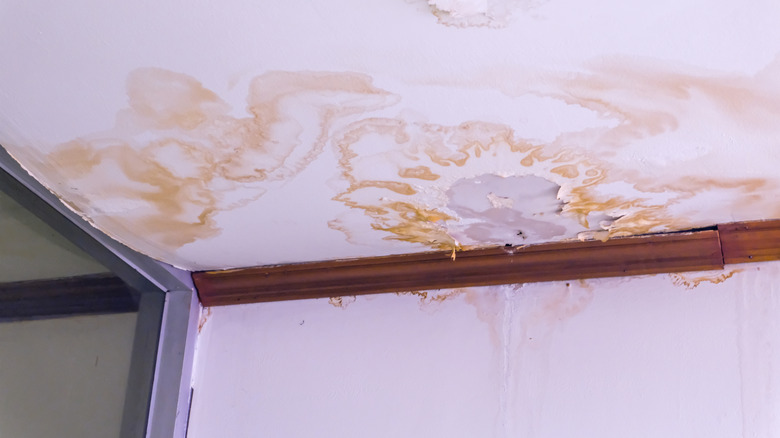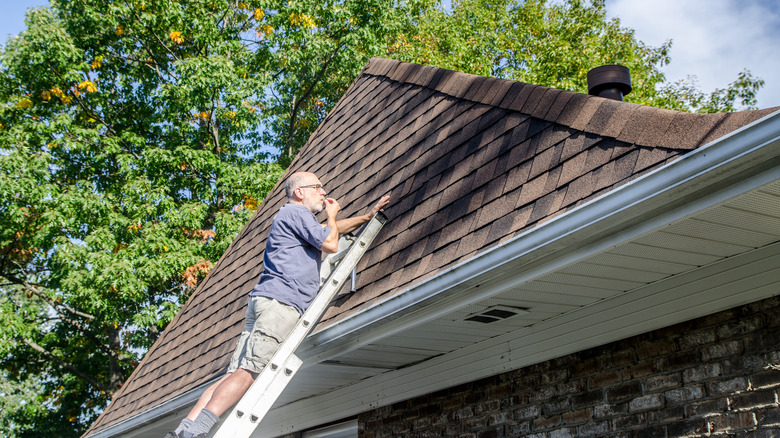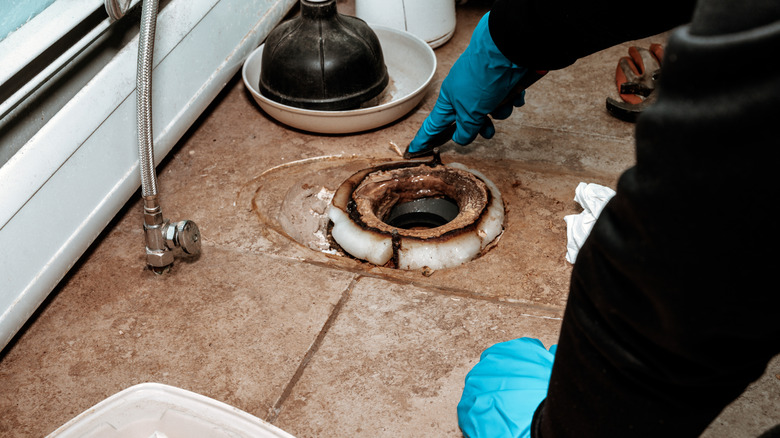How To Identify The Source Of A Leaky Ceiling
There's nothing quite like the sinking feeling that water coming out of the ceiling inspires. Is it a rogue plumbing pipe or a damaged roof? Do you have to deal with water leaking from a ceiling sprinkler? Or, is the universe testing your patience with random drips with no apparent rhyme or reason? Before you start imagining the worst, know that it's fixable; you just need to track down where the leak is coming from. Start by carefully examining the water-stained area. Look for obvious signs of collection points, like bulges or water trails. Often, finding the leak means going up to your attic or observing your roof. And if the culprit isn't within the structure, it's time to take the investigation outdoors. By the end of it, you'll have a much better idea of where that unwelcome indoor waterfall is coming from.
Unfortunately, household leaks could be surprisingly wasteful. According to the Environmental Protection Agency, plumbing leaks can gulp down nearly 10,000 gallons of water every single year. That's like filling a small swimming pool just from what drips above your head. Signs of a leaky ceiling include peeling paint, sagging or cracked surfaces, and brownish stains. You may also notice damp spots on the ceiling on higher household floors that show up after a heavy downpour. Ignoring these clues means you're leaving a ticking time bomb on your ceiling that will eventually explode in the form of structural headaches and mold growth. Tracing the source can, however, spare you thousands in repairs and a great deal of aggravation.
Identify what's causing your ceiling leak
Locate where the water from the ceiling leak is pooling. Mark the damp area, and position a bucket underneath to manage it while you work out a solution. Be aware that the leak is not always at the spot where water drops. Water can travel along beams, pipes, or ceiling joists before revealing itself as a drip. That's why you need to search for all points of accumulation around the puddle to find the source of a water leak. Once you've marked the area, work your way upward, cutting out your ceiling drywall if needed to inspect the joists and underside of any flooring above for signs of a water path. Grab a flashlight to check the space in the attic above the leak, including identifying wet insulation above the ceiling. If it's coming from the roof, inspect the underside for wet spots. Roof leaks usually start high and let gravity carry them down, often traveling several feet before dripping from the ceiling. So, the real problem is usually farther up the slope. In the attic, water stains on the rafters will tell you where the water is coming from.
For leaks coming from outside, gutters are a common cause. Deteriorated or poorly maintained gutters could redirect water straight into your ceiling. Then, move on to the roof itself, climbing the ladder if you must. Spots along the roof's edges where snow melts and refreezes to create ice dams are common starting points. If you notice any cracked shingles, that might confirm your suspicion. While you're at it, check the metal flashing next to your chimney and other areas of entry like skylights or vents. Even a tiny crack there can let the water in.
Steps to fix your leaky ceiling
You may be able to fix minor plumbing leaks originating inside the house easily enough. Begin by checking supply lines under sinks and around toilets. Tighten fittings and replace anything that's dripping. If the leak is coming from a pipe inside the wall, you'll need to carefully remove a section of drywall to get to it. Turn off the water supply before making any attempt to fix the pipe. Severe leaks could require professional intervention, but you might be able to use easy-to-install couplings to fix minor leaks. Meanwhile, adhesive tapes and gasket clamps can often provide temporary relief until you work out a more permanent fix.
Bathrooms deserve special attention. Leaks have the potential to originate from showers, tubs, and faucets. So, be sure to re-seal edges where water meets the ground. Also, tighten showerheads with fresh Teflon tape, and inspect for leaks in drains or overflow openings. Toilets may betray you with a ring of water at their base. Most of the time, this means it's time to replace the wax seal and examine the flange.
Outside, the tools are different, but the principle remains the same. Determine the route water takes. Inspect your gutters, flashing, and roof shingles for signs of damage, and replace them if necessary. If you live somewhere that gets brutally cold, consider insulating your attic, clearing snow from the roof frequently, and repairing seals around entry points to prevent water from leaking in through sliding doors, windows, or other fixtures on higher floors.


